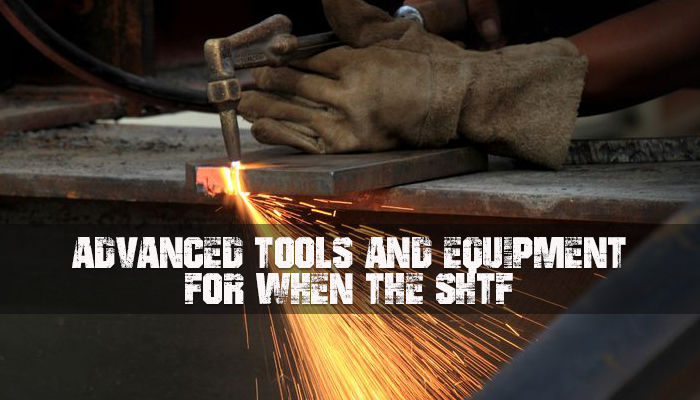
An acetylene/oxygen flame burns at about 3,773 K or 6,332 °F/3500 C. Imagine, what can you do with that kind of heat and it doesn’t take any electricity to operate one. Of course, the tanks will deplete over time, but a torch like this is not something you would use every day, so you could conserve and have a valuable survival tool for months or even years to come. However, it takes a certain skill level to cut metal, weld and to shape metal with an acetylene torch. You can even melt iron, steel, silver, and gold with a torch that produces high heat.
A torch like this can be dangerous, so make sure you know how to use one, how to transport, and store one before running out and getting one.
Heavy Duty Floor Jack and Smaller Jack
You may need to move or adjust foundation or support timbers if building a cabin or shelter post-crisis, and of course, you may need to lift vehicles to change tires, or to lift a transmission or engine off its mounts. Thus, you need a heavy-duty jack. Keep in mind, the jack you have now may suit your needs and vehicles but once the SHTF, you may need to use a jack on considerably heavier equipment or objects you come across as you try to survive.
You will know when you need a heavy-duty jack, and if you don’t have one, then what.
The newer battery boxes not only jumpstart a vehicle but they also have USB ports for charging cell phones, laptop computers or any electronic device that uses a USB port. Jump boxes usually have an air pump that will inflate a vehicle tire, however, it will take some time for it to fully inflate a flat tire, and you may have to shut the box off after 10 minutes of continual use, to allow it to cool, to prevent overheating, but it will get the job done. Most boxes have built in lights and some even have removable lights and built in emergency radios for weather and other reports.
Most battery boxes do not actually “jumpstart” a vehicle, however. The cranking amps are limited in the boxes because there is a relatively small battery inside the box that stores the power, so there are limits to what you can do as far as jump starting a dead vehicle battery. Typically, you attach the clamps and allow the box’s battery to essentially add enough charge to the dead battery in the vehicle before turning over the engine. You are transferring a charge from the box’s battery to the vehicle battery.
It does take electricity, of course, to recharge the battery box, but a small solar panel would work nicely to charge the box and other small devices you have on hand. It will take longer, so adjust to accommodate for the longer charging time.
A Halligan bar also called a Halligan tool is a forcible entry tool used by firefighters and law enforcement, and has found service in some military units as well, but under a different name with slightly different design aspects.
This truly is a multi-tool used for punching holes, prying, twisting, or striking. It has a claw, a blade, a wedge, and a pick end, which is mainly used to breach door locks quickly.
They come in various lengths from 18 to 54 inches, and the longer ones can weigh as much as 12 pounds. For most people, not involved in rescue operations as part of their job, the 18 or 24-inch models would be ideal. The 18-inch bars can conceivably be carried on your person by strapping to a pack or by attaching to a pack harness.
As with a battery box, a cordless drill would have to have the batteries charged, so before buying portable tools that use batteries you need a way to charge those batteries once the SHTF.
There are any number of uses for a drill around the home over even around a campsite when the SHTF. Punch holes in leather, use the spinning chuck to create friction and start a fire, drill holes in metal or wood to lighten the object not to mention use a drill as a power screwdriver. The uses are endless and you will find you will use one if you have one almost on a daily basis.
Additional Tools and Materials
- A quality set of masonry, metal and wood drill bits
- Machine oil/lubricant
- Quality bolt cutter (not the ones for 10 bucks at a Dollar store or Wal-Mart’s, they will snap even under slight pressure)
- Set of wood and metal files
- Punch set
- Rubber mallet
- Vise
- Quality electrical tape
The lists above are not comprehensive by any means, but it is a start. Remember some if not many of the tasks you do today will still have to be done once a disaster strikes. You may hire out some of the tasks today, but you will not be able to do this once something happens. Do you have the tools and skills to survive?